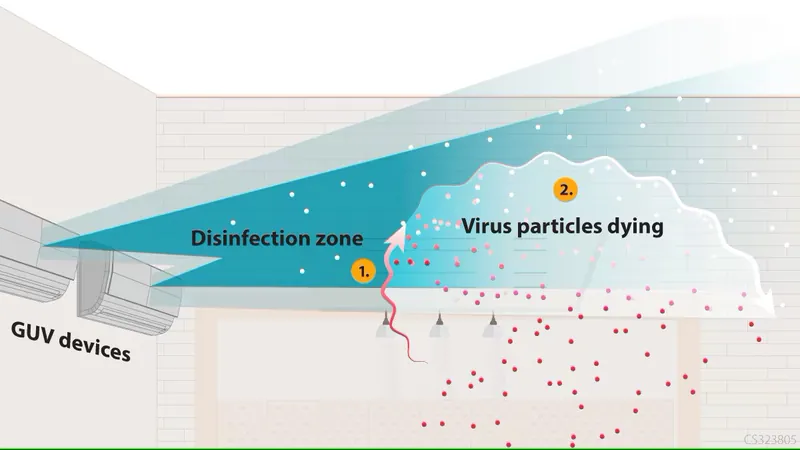
Revolutionizing Air Quality: The Power of Upper Room UV-C Technology
2024-12-18
Author: Amelia
In 2020, the world faced a formidable and deadly adversary with the emergence of COVID-19, sparking a global scramble for protection. The pandemic thrust into the limelight various protective measures, from masks and hand sanitizers to advanced air filtration systems, as people fought to safeguard their health. Yet amid this crisis, one technology has remained surprisingly overlooked: upper-room UV-C sterilization.
This innovative approach, reminiscent of science fiction, effectively combats airborne pathogens while providing a subtle illumination. Although it sounds futuristic, upper-room UV technology has existed for approximately 80 years. The principle is straightforward—by positioning UV-C lights in the upper reaches of a room, it can eliminate harmful microorganisms from the air before they can be breathed in by people below.
The basis for this remarkable technology can be traced back to the 19th century, when scientific studies revealed that sunlight has the power to inhibit the growth of harmful microbes. Subsequent research demonstrated that UV-C light, specifically in the range of 100 to 280 nanometers—with peak effectiveness at 250 to 270 nanometers—was exceptionally adept at killing or inactivating bacteria and viruses. This capability makes it invaluable for addressing a range of airborne threats, including diseases like TB, measles, and more recently, SARS-CoV-2.
However, caution is essential. While UV-C light can effectively target pathogens, it also poses risks to human health, potentially causing skin burns and eye injuries. There have been concerning incidents, such as one in 2023 involving the accidental use of UV sterilization lamps as decorative lighting, leading to health hazards. This is why upper-room UV-C systems are engineered to ensure that the harmful UV light remains safely above the heads of occupants, allowing effective air sterilization while minimizing risk.
These systems are particularly advantageous in high-ceiling environments like schools, hospitals, and airports. To adhere to safety guidelines from the CDC, these installations require ceiling heights of at least 8 feet, ensuring that the emitted UV-C light sterilizes the upper air zone while allowing those below to safely breathe the treated air.
The design of upper-room UV systems enhances their efficacy by promoting air circulation. Utilizing natural convection and HVAC systems, as well as fans, the UV-treated air is constantly mixed back into the lower air zone, effectively creating a continuous sterilization process. Remarkably, studies have shown that only a relatively low power output of 15-20 milliwatts per cubic meter is necessary for effective air treatment, given adequate air circulation.
However, proper installation is crucial to maximize safety and effectiveness. Missteps can lead to dangerous exposure to UV light, resulting in immediate health issues such as eye irritation and skin burns. Special shielding and louvered fixtures help ensure that direct and reflected UV rays remain out of the lower zones, preserving occupant safety while maintaining high sterilization levels overhead.
Although upper-room UV technology has been in use since as early as the 1930s, there remain considerable gaps in its widespread adoption today. Historical successes in reducing post-surgical infections at facilities like Duke University and controlling measles transmission in classrooms showcase its potential. Yet, despite its proven efficiency, these systems are not commonplace. Cost considerations—both for installation and maintenance—often outweigh perceived benefits, leaving this effective technology on the sidelines in many high-risk environments.
The relevance of upper-room UV-C sterilization has only grown in the wake of multiple airborne disease outbreaks, revealing a striking paradox: we continue to ignore a technique that has stood the test of time. As the world grapples with ongoing health crises, it's time to reconsider the simplicity and effectiveness of upper-room UV. With minimal effort—installing fixtures in strategically chosen locations—significant strides can be made in the quest for cleaner air. The pressing question remains: why aren't we utilizing this effective solution to combat airborne pathogens across all public spaces?









 Brasil (PT)
Brasil (PT)
 Canada (EN)
Canada (EN)
 Chile (ES)
Chile (ES)
 España (ES)
España (ES)
 France (FR)
France (FR)
 Hong Kong (EN)
Hong Kong (EN)
 Italia (IT)
Italia (IT)
 日本 (JA)
日本 (JA)
 Magyarország (HU)
Magyarország (HU)
 Norge (NO)
Norge (NO)
 Polska (PL)
Polska (PL)
 Schweiz (DE)
Schweiz (DE)
 Singapore (EN)
Singapore (EN)
 Sverige (SV)
Sverige (SV)
 Suomi (FI)
Suomi (FI)
 Türkiye (TR)
Türkiye (TR)